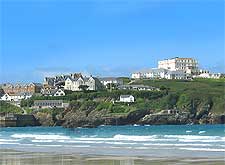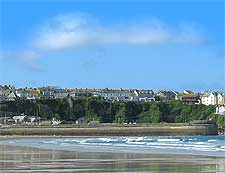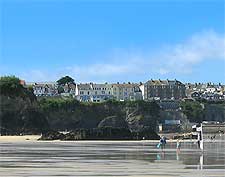Newquay History Facts and Timeline
(Newquay, Cornwall, England, UK)

Newquay's history began some 1,600 years ago when an Iron Age hill fort was built. With its six ramparts and ditches, it must have made a formidable stronghold in its day.
There is also evidence that settlers smelted deposits of ore found nearby, which they then used to make weapons and tools. From these earliest times to the Middle Ages, it's believed that this site was occupied continuously.
Growth of a Fishing Village
It is not known at what point a small fishing village grew up on the present site of Newquay. Certainly, by the 15th century, records show that it was then known as Towan Blistra, which means 'blown sand dune' in the native Cornish language.

In 1439, the building of a New Quay was approved by Bishop Lacey of Exeter. The construction of a harbour meant that the town could now be sheltered from strong winds, allowing the local fishing industry to prosper. Pilchards were the most popular catch for Newquay's fishermen. When a shoal was spotted, fishermen were alerted from the Huer's Hut, perched high above the harbour.
During the 17th and 18th centuries, the pilchard industry started to wane. The port started to be used as much for loading local mineral goods, such as lead tin and china clay, as for fishing. In 1846, a goods rail line was opened, connecting the inland clay and copper ore mines with a terminus at Newquay Harbour.
[

Victorian Newquay
During the 19th century, Newquay was discovered by a new breed of visitor. Victorian holiday makers were drawn to its beaches and appealing microclimate. What's more, they could now reach the town easily from
London, thanks to the introduction of passenger trains in June 1876. The original station consisted of just a single platform. It wasn't until 1905 that the station was rebuilt and extended. To cater for growing demand, hotels and boarding houses sprang up throughout the town.
During the 1900s, Newquay also became known for its burgeoning woollen textiles industry. Seven local factories supplied high quality knitted garments for top London stores, including Debenhams.
The inhabitants of Newquay have witnessed many shipwrecks since the harbour was first built. Most notably, in March 1908, 'The Hodbarrow Miner', a topsail schooner, was wrecked off Longships Lighthouse. Its single survivor was rescued by local lifeguards. In March 1912, a three-masted schooner 'Bessie' was wrecked in Newquay Bay and the crew was rescued by the town's rocket brigade.
 Newquay's history began some 1,600 years ago when an Iron Age hill fort was built. With its six ramparts and ditches, it must have made a formidable stronghold in its day.
Newquay's history began some 1,600 years ago when an Iron Age hill fort was built. With its six ramparts and ditches, it must have made a formidable stronghold in its day. In 1439, the building of a New Quay was approved by Bishop Lacey of Exeter. The construction of a harbour meant that the town could now be sheltered from strong winds, allowing the local fishing industry to prosper. Pilchards were the most popular catch for Newquay's fishermen. When a shoal was spotted, fishermen were alerted from the Huer's Hut, perched high above the harbour.
In 1439, the building of a New Quay was approved by Bishop Lacey of Exeter. The construction of a harbour meant that the town could now be sheltered from strong winds, allowing the local fishing industry to prosper. Pilchards were the most popular catch for Newquay's fishermen. When a shoal was spotted, fishermen were alerted from the Huer's Hut, perched high above the harbour.